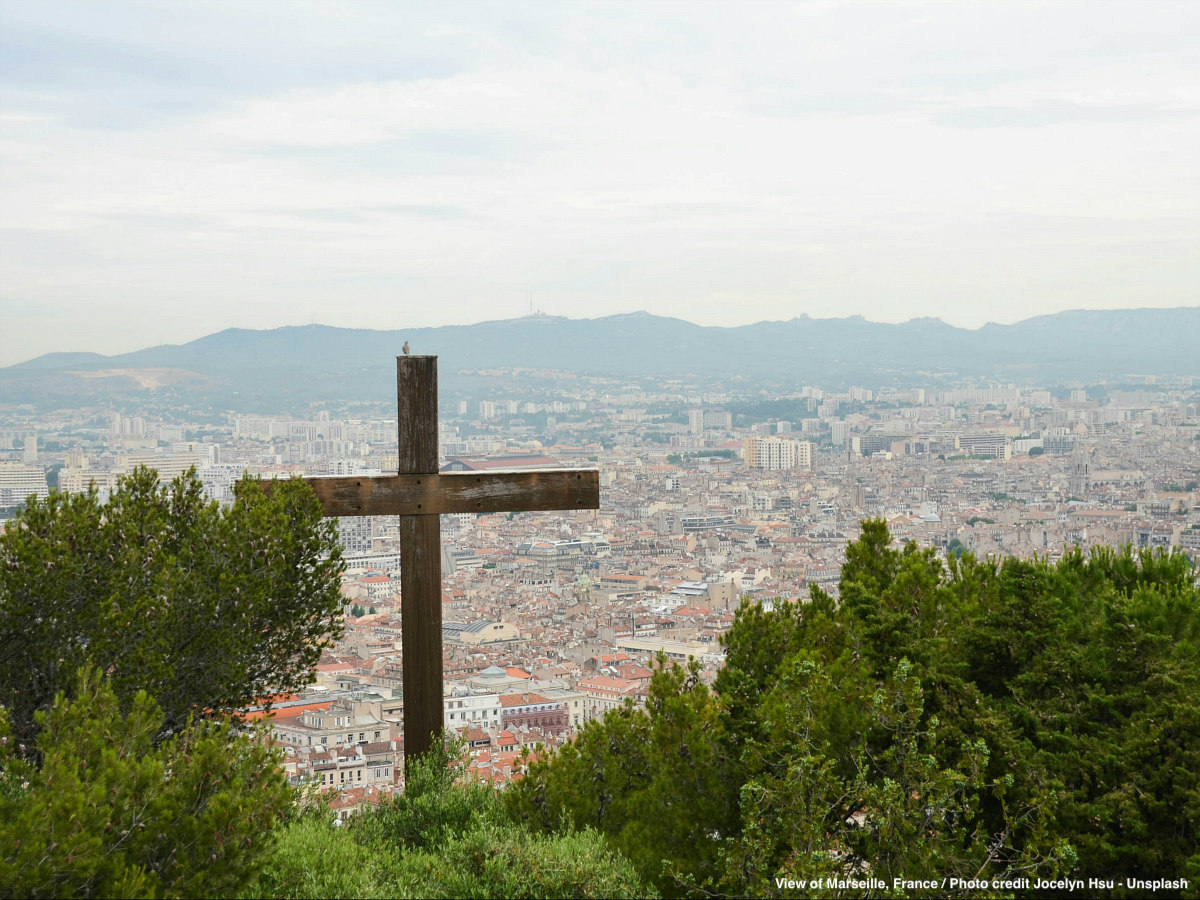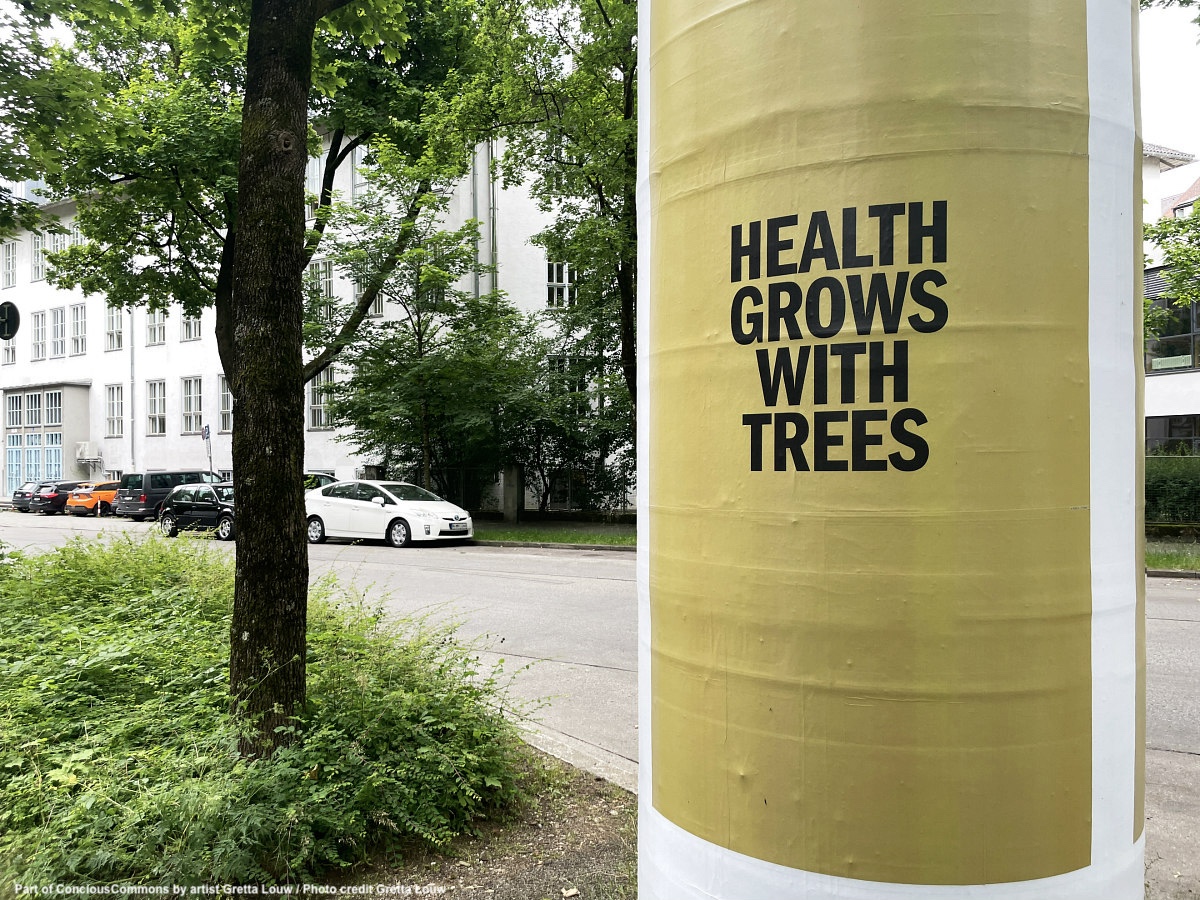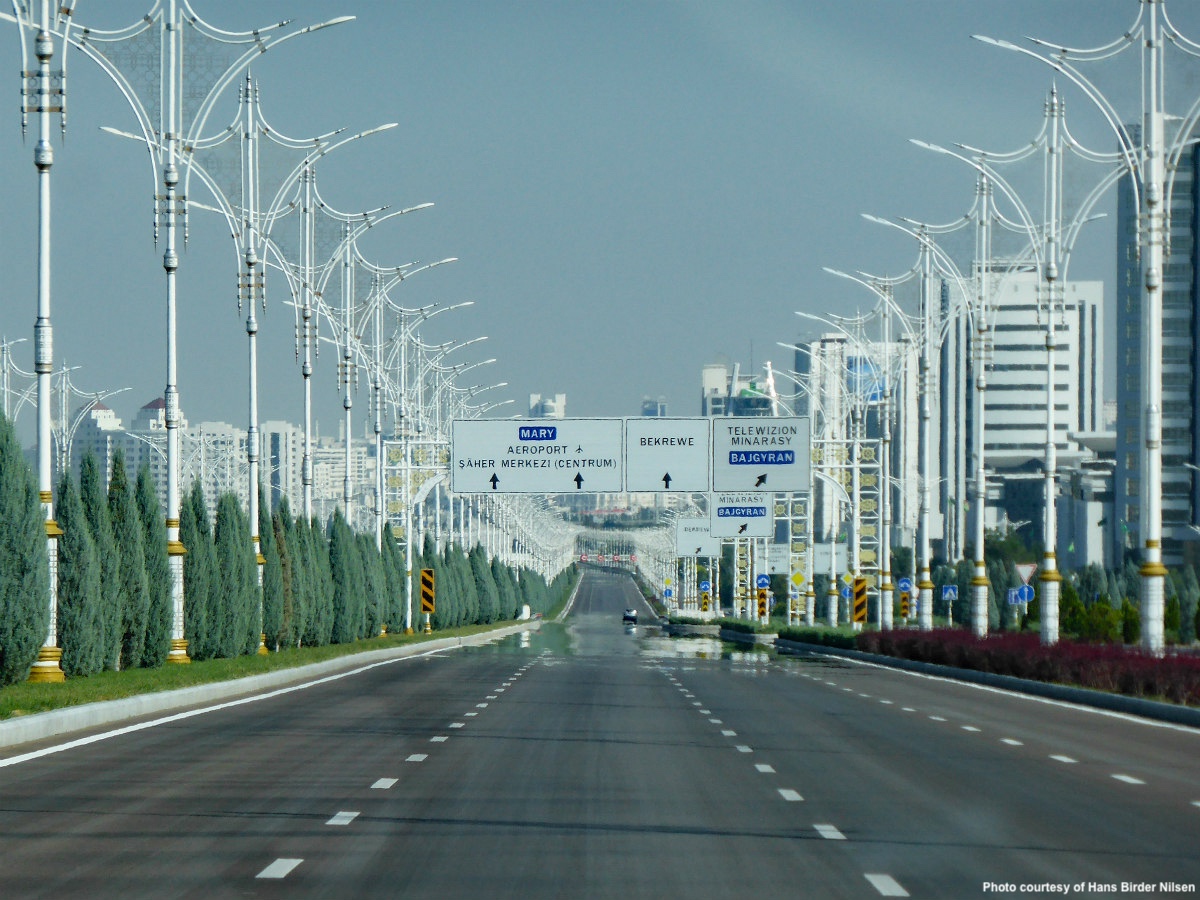On a balmy Wednesday afternoon at the end of August, I headed to an appointment in the neighborhood of Schwabing, Munich, without knowing that I would actually meet one of the world’s pioneers of augmented reality art. Contrary to her grandee status, the American artist Tamiko Thiel has a warm and informal manner. For the past two-and-a-half decades, she has pushed the boundaries of “painting”, potentially changing how we see the world around us.
Despite a hard-won career from her base in Munich, her work is mostly internationally acclaimed. Her art pieces are now in the MoMA and Whitney Museum permanent collections in New York and the Smithsonian Institution. Yet many of Thiel’s artworks are visible to anyone from anywhere in the world. This is what makes augmented reality art so fascinating.
Although Thiel admits it takes a long time to get the general public familiar with this technology, what she’s aiming for is that “augmented reality will be the street art of this century.” This technology has never been more appealing than now, when so many artists are finding a new space to express themselves and use this art form to digitize difficult issues.
Instead of brushes and sprays, Thiel uses programming to create three-dimensional art works, apparently integrated in a physical location, and only visible to the human-eye through the screen of a smartphone or tablet. No permits to paint walls or to use the public space are obvious advantages of this art form. However, more steps, or rather clicks, separate viewers from a piece of augmented reality art than a spontaneous look to a wall. The access is easy, though.
Depending on the artwork, viewers can simply open a browser to access a website and look for the button to launch the augmented reality pieces or download the corresponding augmented reality app on their iPhone or Android. The same system that Pokemon GO uses. Over forty of Thiel’s works run in her own app ARpoise. Artists using augmented reality enjoy the freedom of placing their artworks wherever they like, for the enjoyment of people. “I use google maps to find the GPS coordinates to place things in places where I am not physically present,” explains Thiel.
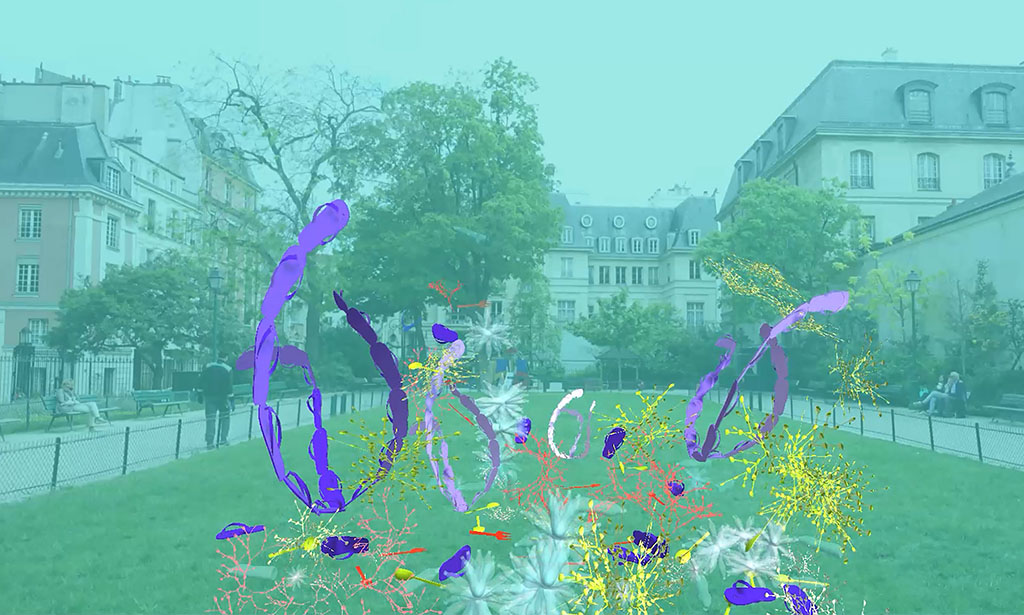
There are two different location approaches which artists can use in the technical setup. One is geo-fencing, the piece can only be seen by viewers with their mobile phones in a certain location, the other allows you to see the piece with your phone no matter where you are in the world. Nothing changes in our physical environment, but artists put their faith in the symbiosis of the piece and the surrounding of the viewer to create a different meaning while the viewer’s own harmony with the environment disintegrates.
Thiel’s new augmented reality installation, with the blameworthy title “What You Sow”, on as part of the Marais DigitArt Festival, has submerged the Square Léopold-Achille in Paris underwater. Virtual plastic garbage in the form of flip-flops, rubber ducks and plastic cutlery fall from the sky. When users tap on the plastic “seed corals”, a complex branching “plastic waste coral” grows out of every piece, engulfing the users in plastic. Over time the corals bleach and shrink, turning into invisible microplastics, but an endless supply of new plastic “seeds” fall from the sky to grow more garbage corals. The installation offers an uncomfortable truth about human interference with the environment, all under a creaking underwater-like sound.
***
Thiel went to the Academy of Arts in Munich but her in-depth computing knowledge and experience was nurtured in the US. Born in Oakland, California, she graduated with a bachelor’s degree in general engineering / product design at Stanford University in 1979 and obtained a Masters in Mechanical Engineering at MIT in 1983. She worked with Danny Hillis in the famous “Connection Machine CM-1 / CM-2” (1986 / 1987, Thinking Machines Corp.), the first commercial supercomputer for Artificial Intelligence that would influence Google’s AI technology and also inspired Apple co-founder Steve Jobs.
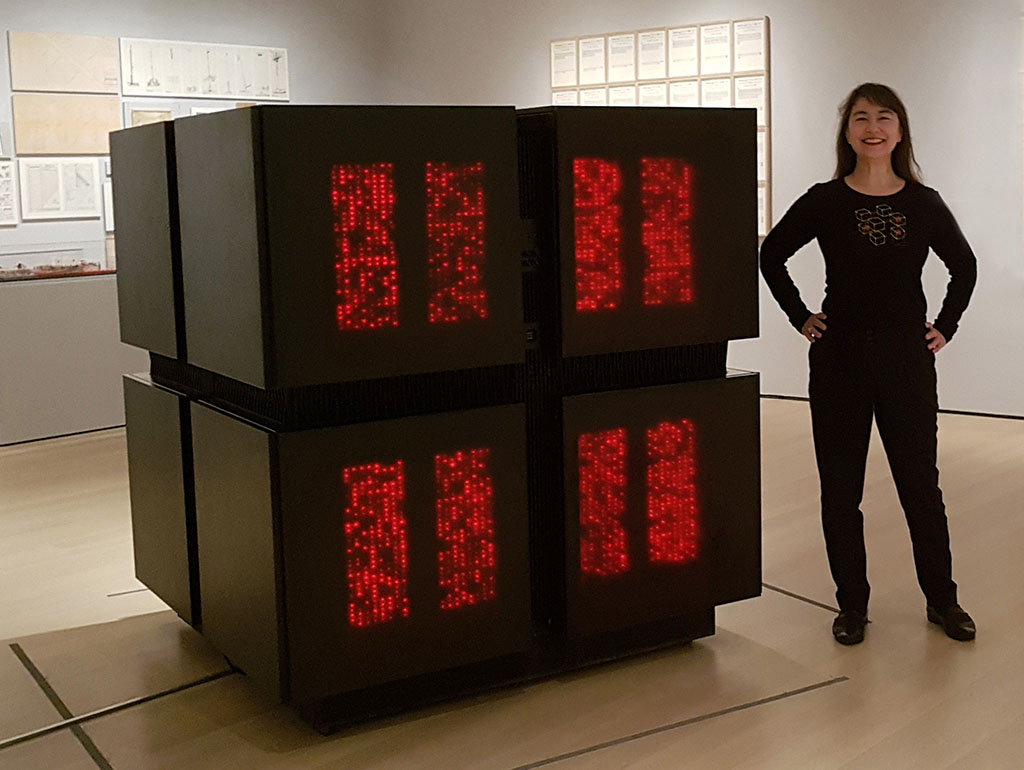
Early on in 1994 she began to work with virtual reality. After a couple of relatively fallow years during which virtual reality was considered to be “dead”, she jumped into this augmented reality art world with some guerrilla interventions. Something that draws a parallel with street art artists illegally painting walls and subways in the 80s, creating critical-reflexive works.
In 2010 Thiel participated in the first guerilla intervention “We AR in MoMA,” organized by augmented reality artists Mark Skwarek and Sander Veenhof. Announced ahead of the guerilla flash mob at the MoMA in New York, the museum surprisingly tweeted: “Nice, looks like we’re having an “uninvited” AR exhibition tomorrow!” The next day Thiel’s “Art Critic Face Matrix”, a floating array of white faces with open mouths, appeared on one of the floors of the museum intermingled with the exhibition.
After this successful experience Thiel, together with Skwarek, Veenhof and other international artists, founded the collective Manifest.AR to advocate for interventionist public art using emerging forms of augmented reality. The Virtual should not be confined to a stagnant screen but rather data could be transformed into imagery that can co-exist in public spaces. In an increasingly technological society, Thiel aimed at challenging the status quo of the art elite and public institutions stimulating a new discourse.
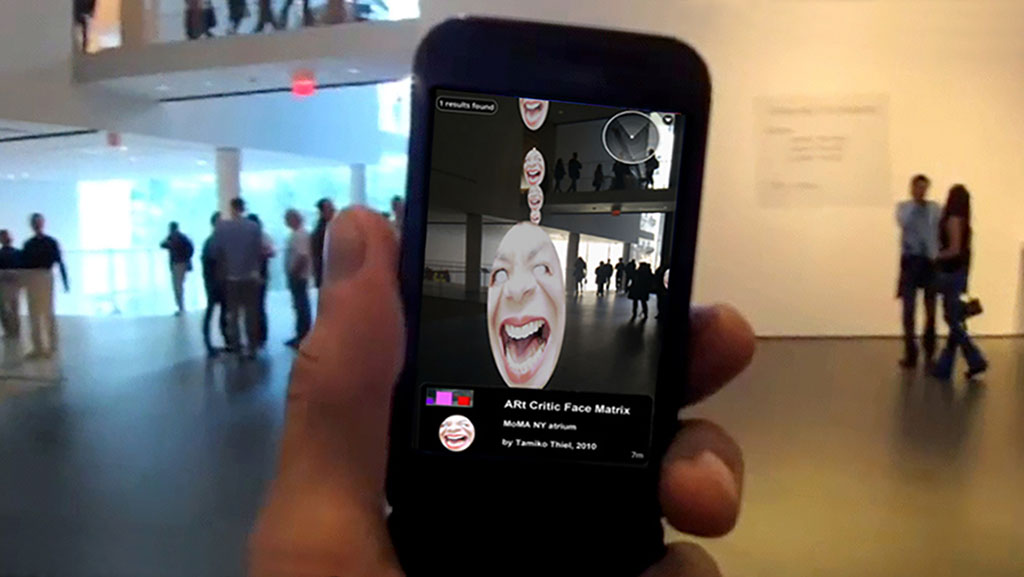
During the Venice Biennale in 2011, together with Veenhof, she curated another ‘uninvited’ intervention by Manifest.AR that declared to extend the Giardini with extra pavilions constructed in the new medium of augmented reality – some of these works also leaked out into the public space of Piazza San Marco. One of them was Thiel’s “Shades of Absence”, the gold silhouettes of contemporary known and lesser known artists whose works have been censored or are persecuted with no public support.
The same year the Occupy Wall Street movement made a call to augmented reality artists to virtually access the New York Stock Exchange since police had blocked protesters from entering the area. Thiel’s “Reign of Gold” was part of “AR Occupy Wall Street” organized by Mark Skwarek that surrounds the viewer with a rain of $50 gold eagle coins.
These interventions draw the attention of the art and cultural world that began to see in augmented reality the potential of a “programmed” street art using instructions, sets of rules, and code that can also speak out for the challenges that our society faces. From there many other art commissions followed.
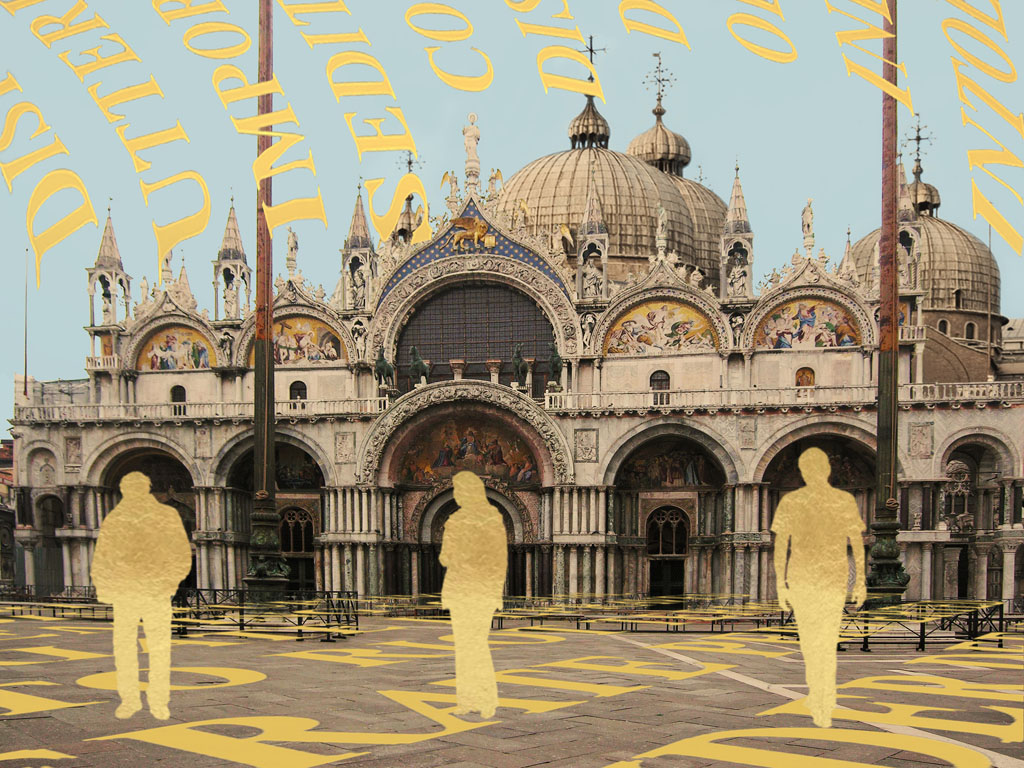
In 2012 Thiel worked also as AR art advisor for the street art project “Mi Querido Barrio” (translated “My Beloved Neighborhood”) with the Caribbean Cultural Center and African Diaspora Institute (CCCADI) in East Harlem that used augmented reality to put the community’s art, culture and history on the streets of East Harlem. Invited by the CCCADI to also contribute a work, Thiel wanted it to project the voices of the neighborhood itself. “For my piece we asked residents, “What makes El Barrio feel like home?” I took their handwritten and hand signed answers and transformed them into golden words that swirl around you when you scan the facade of the CCCADI building,” explains Thiel.
In 2018 Thiel was awarded the iX Visionary Pioneer Award from SAT Montreal for her life’s work that deals with social, historical and environmentally critical issues and focuses on the relationship between body, space and technology.
***
Thiel’s work has been echoed by new artists exploring augmented reality in their art practices, with image or sound, as a tool for socially engaging experiences in the urban environment that show the creative potential for a new way of activism. In 2020 the award-winning media artist, musician, producer Anne Wichmann, together with award-winning actor Clara Francesca, founded The Extended Reality Ensemble, a collective of international interdisciplinary creators and curators who combine artistry and technology to raise awareness on social issues and advocate for equity. During the Ars Electronica in Linz this year, I experienced their immersive interactive game “You Are BUTIFL” that explores the biases of AI graphic apps when defining beauty and ugliness that rule our everyday lives.
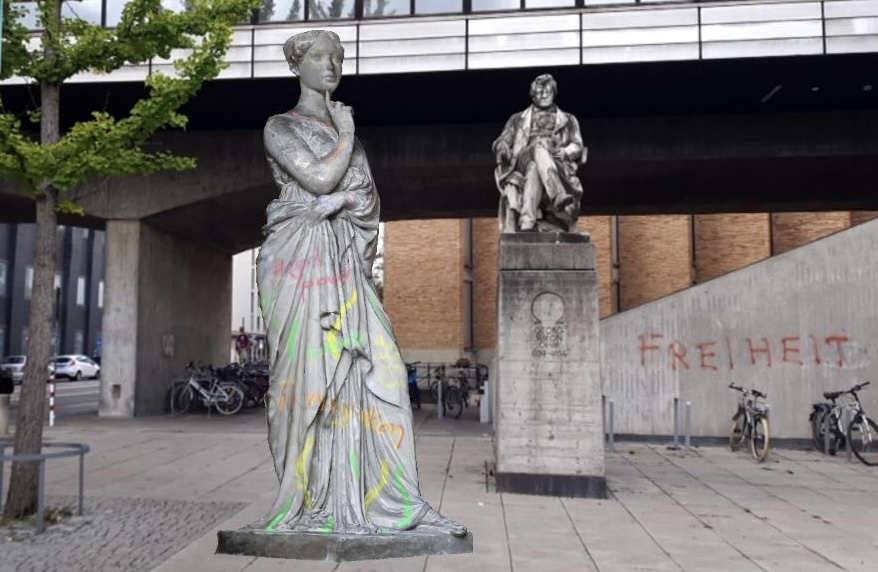
Based both in New York, they launched the project ARORA in 2020, with curator and writer Katie Peyton Hofstadter and Nam Le, founder of Pollinate Art, to place digital statues of gender expansive persons in cities around the world. They saw in augmented reality a great opportunity to accelerate gender equality. City governments are moving so slowly that it took six years for the activist group Monumental Women to unveil the first statue of real women in Central Park in 2020 after tremendous resistance and tedious bureaucracy. And that although 91% of the sculptures in New York City depict men.
“We are addressing with technology a problem that is acute in all the cities. Thanks to augmented reality, we can quickly increase the number of female and non-binary monuments in cities and counter-balance a male majority. In New York alone we increased the quota from roughly 6% to 21% of the total city monuments,” explains Wichmann.
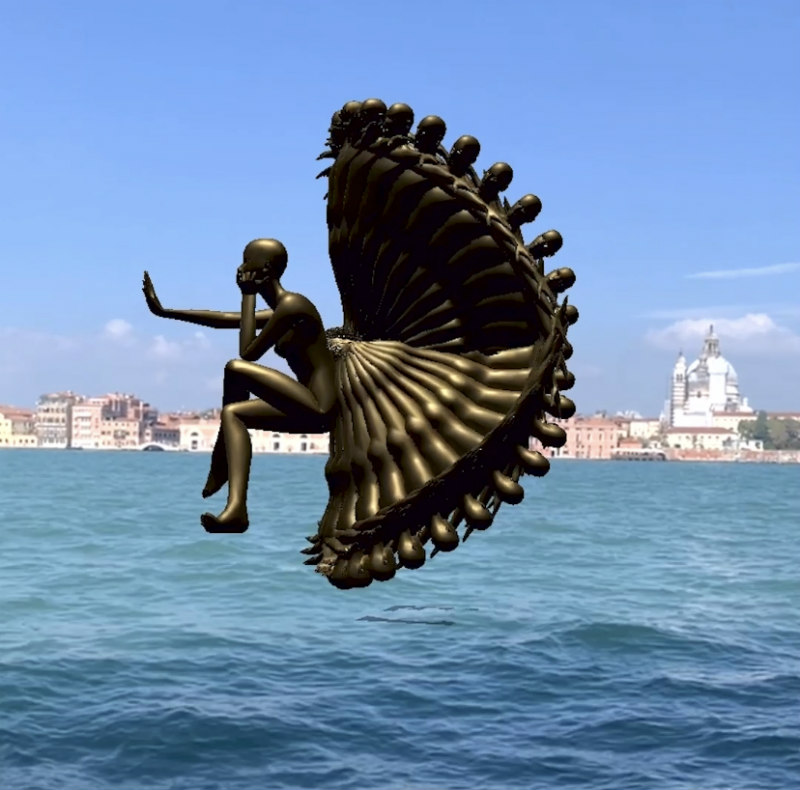
The ARORA activist initiative was also launched in Munich, Wichmann’s hometown, where they have the support of the city authorities, she tells me over Zoom from New York. American multimedia artist and a founding member of the collective Manifest.AR, Will Pappenheimer, introduced Wichmann to Thiel’s work who ended up participating in ARORA in Munich with the creation of #JulietToo, with a cloud of body-positive amazon and viking avatars of the Juliet Capulet statue (from “Romeo and Juliet”) situated in downtown Munich. Passers-by have been rubbing the patina off the bronze statue’s breast since its placement in 1974, presumably to bring themselves good luck, leaving a shining golden breast in the otherwise dark green statue. “In many countries women’s right to control their own bodies is under full attack, #JulietToo reclaims the naked female breast as a sign of women’s power, not subservience,” says Thiel.
Actually, users can click on the project on the ARORA website to bring Juliet to their own cities, since all the art pieces are visible anywhere in the world. “We want as many people as possible to see the monuments. The more people can see them, enjoy the art and are aware of the gender equity issue with statues, the better,” explains Wichmann. And she adds, “The beautiful thing about digital art is that it can travel so easily. You only need a smartphone. We curate digital art that can be shown at different places and provoke a conversation through that medium. You can look at the art piece from different perspectives, walk around it, interact with it and have fun, while it is also socially relevant,” says Wichmann.
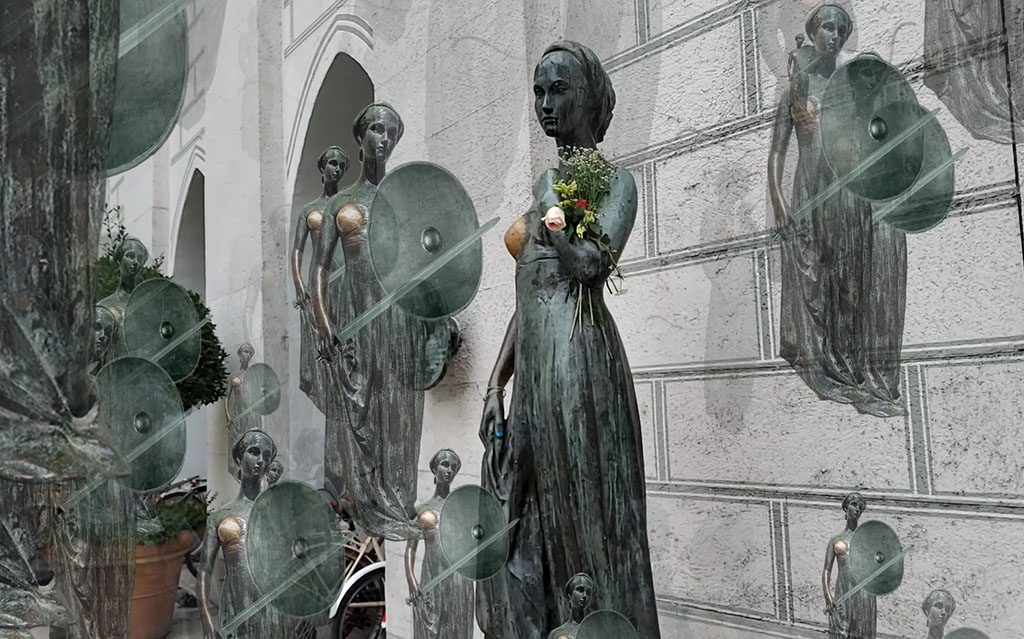
Remembering an event in Haus der Kunst in Munich, she continues, “I saw men in their 70s who were really getting into augmented reality art, trying to understand it. A lady came to me disappointed because she didn’t have a smartphone. I lent her mine and she explored all the digital statues exclaiming “this is amazing!” These little moments with people that usually don’t use this type of technology are very rewarding. This is a huge part of why I am doing this.”
This year’s Ars Electronica theme is ‘Who owns the truth?’ I saw lots of augmented reality projects at the exhibition that uphold truths that our physical environment hasn’t been able to provide. I asked Thiel at the end of our conversation how she sees herself, and she immediately clarified “I am not an activist, because in activist circles that term means you are willing to put your life on the line for your cause! I am rather an evangelist.” One way or the other, this new form of street art has the creative potential to galvanize people into action that ultimately could alter the physical world in a positive way beyond the virtual space.


